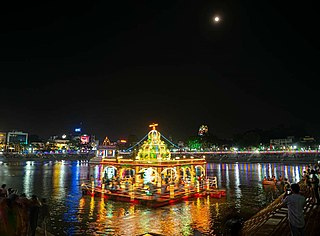
Mylapore is a neighborhood in the central part of the city of Chennai, India. It is one of the oldest residential parts of the city. It is also called Thirumayilai. The locality is claimed to be the birthplace of the celebrated Tamil philosopher Valluvar.

The Parthasarathy Temple is an 6th-century Hindu Vaishnavite temple dedicated to Vishnu, located at Thiruvallikeni, Chennai, India. The temple is glorified in the Divya Prabandha, the early medieval Tamil literature canon of the Alvar saints from the 6th to 9th centuries CE and is classified as among the 108 Divya Desams dedicated to Vishnu. The name 'Parthasarathy' means the 'charioteer of Arjuna', referring to Krishna's role as a charioteer to Arjuna in the epic Mahabaratha.

The Dilwara Temples or Delvada Temples are a group of svetambara Jain temples located about 2+1⁄2 kilometres from the Mount Abu settlement in Sirohi District, Rajasthan's only hill station. The earliest were built by Vimal Shah and supposedly designed or at least financed by Vastupala, Jain minister of Dholka. They date between the 11th and 16th centuries, forming some of the most famous monuments in the style of Māru-Gurjara architecture, famous for their use of a very pure white marble and intricate marble carvings. They are managed by Seth Shri Kalyanji Anandji Pedhi, Sirohi and are a pilgrimage place for Jains, and a significant general tourist attraction. Although Jains built many temples at other places in Rajasthan, the Dilwara temples are believed to be the most impressive.

Nagaraja Temple is an early large temple found in the city of Nagercoil (Nagarkōyil) near the southern tip of Tamil Nadu, India. Its dating is uncertain but likely pre-12th-century. The main sanctum is dedicated to the Nagaraja – the king of serpents. Padmanabham (1985), Heritage Of The Tamils Temple Arts, Editors: SV Subramanian and G Rajendran, International Institute of Tamil Studies, Since the 17th-century, new Hindu shrines have been added to the temple complex attracting devotees of Krishna (Vishnu), as well as Shaiva and Shakti Hindus. The original iconography of the Tirthankaras and Padmavati Devi have and continue to remain a part of the sacred pantheon close to the temple's main sanctum.
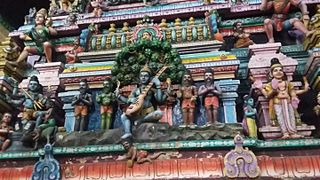
Ravishwarar Temple is a Hindu temple in Chennai, India. Built during the Chola period, the temple is dedicated to Shiva. It is located at Murthy Iyengar Street in the northern neighbourhood of Vyasarpadi.

Saavira Kambada Temple or Tribhuvana Tilaka Cūḍāmaṇi), is a basadi or Jain temple noted for its 1000 pillars in Moodabidri, Karnataka, India. The temple is also known as "Chandranatha Temple" since it honours the tirthankara Chandraprabha, whose eight-foot idol is worshipped in the shrine.
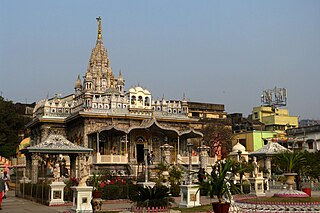
Calcutta Jain Temple is a Jain temple at Badridas Temple Street, Gouribari in Maniktala and a major tourist attraction of Kolkata (Calcutta), India. The temple was built by a Jain named Rai Badridas Bahadoor Mookim in 1867. Pratishtha was done by Sri Kalyansurishwarji Maharaj.

Bangalore (Bengaluru), the capital of Karnataka state, India, reflects its multireligious and cosmopolitan character by its more than 1000 temples, 400 mosques, 100 churches, 40 Jain derasars, three Sikh gurdwaras, two Buddhist viharas and one Parsi fire temple located in an area of 741 km² of the metropolis. The religious places are further represented to include the few members of the Jewish community who are making their presence known through the Chabad that they propose to establish in Bengaluru and the fairly large number of the Baháʼí Faith whose presence is registered with a society called the Baháʼí Centre. In the demographically diverse, major economic hub and India's fastest-growing major metropolis of Bengaluru, the number of religious places of each religion reported reflects growth in proportion to the population growth. According to the 2001 census of India, 79.37% of Bangalore's population is Hindu, roughly the same as the national average. Muslims comprise 13.37% of the population, which again is roughly the same as the national average, while Christians and Jains account for 5.79% and 1.05% of the population, respectively, double that of their national averages. Anglo-Indians also form a substantial group within the city.

Ranakpur Jain temple or Chaturmukha Dharana Vihara is a Śvētāmbara Jain temple at Ranakpur is dedicated to Tirthankara Rishabhanatha. The temple is located in a village of Ranakpur near Sadri town in the Pali district of Rajasthan.
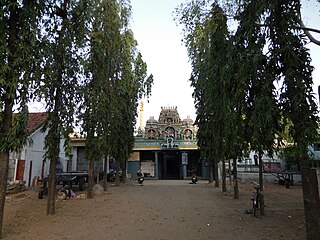
Kachchaleswarar Temple, also known as the Great Kachali Pagoda, is a Hindu temple located in Armenian Street, in the neighbourhood of Parry's corner in Chennai city, Tamil Nadu, India. Constructed on land belonging to dubash Kalavai Chetty in 1725, the temple belonged to the left-hand castes and was the site of the first major conflict between left and right-handed castes in the then Madras city.
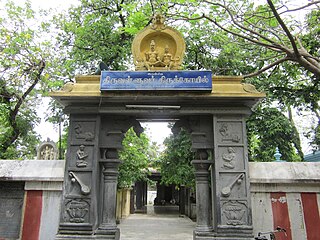
Thiruvalluvar Temple, also known as the Ekambareswarar–Kamakshi Temple, is a Hindu temple dedicated to the poet-saint Valluvar in the neighborhood of Mylapore in Chennai, India. The shrine is located within the Ekambareswarar temple complex. Believed to have been constructed in the early 16th century, the temple was extensively renovated in the 1970s. Traditionally believed to be the birthplace of Saint Valluvar, the temple is the oldest ever built to Valluvar. The temple also serves as the venue for meetings of Tamil language enthusiasts. While many consider the temple as the birthplace of Valluvar, some consider it as his samadhi.

ISKCON Temple Chennai, also known as the Sri Sri Radha Krishna Mandir, is a Vaishnava temple, in Chennai, India. Dedicated to the Hindu god Krishna, the temple is located on the East Coast Road in the southeastern coastal suburb of Akkarai. It is built on 1.5 acres of land, the International Society for Krishna Consciousness (ISKCON) Chennai. It was formally inaugurated on 26 April 2012.

Nearly 33,000 ancient temples, many at least 800 to 2000 years old, are found scattered all over Tamil Nadu. As per Tamil Nadu Hindu Endowments Board, there are 38,615 temples. Most of the largest Hindu Temples reside here. Studded with complex architecture, variety of sculptures, and rich inscriptions, the temples remain the very essence of the culture and heritage of Tamil land, with historical records dating back to at least 3,000 years.

Jagannath Puri Temple Chennai is a Hindu temple dedicated to the divine trinity Jagannath, Baladeva and Subhadra in Chennai, India. The temple located in Kannathur off the East Coast Road by the seaside is built in Kalinga architecture reminiscent of the Jagannath Temple, Puri. The temple has shrines dedicated to Shiva, Ganesh, Bimala. The annual Rathyatra is the main festival celebrated.

Anna Nagar Ayyappan Koil is a Hindu temple dedicated to the deity Ayyappan in Chennai, India. It is located at the junction of 6th Main Road and 2nd Avenue in Anna Nagar.

Guru Basadi is a basadi or Jain temple located in Moodabidri town in the state of Karnataka. The Guru basadi is the oldest amongst 18 Jain basadis in Moodabidri built in 714 CE. This temple is near the another famous Jain temple, Saavira Kambada Basadi.

Madhava Perumal Temple is dedicated to Hindu god Vishnu located in Mylapore, Chennai, in the South Indian state of Tamil Nadu. Constructed in the Dravidian style of architecture, dedicated to Vishnu, who is worshipped as Madhava Perumal and his consort Lakshmi as Amirtavalli. The temple is believed to be the birthplace of Peyazhwar, one of the first three of the twelve azhwar saints of the 6th-9th century CE.
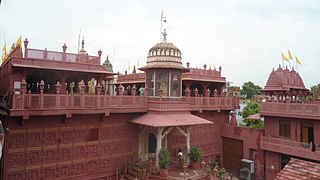
Shri Digamber Jain Atishya Kshetra Mandir, Sanghiji is an ancient Jain temple in Sanganer, Rajasthan made of red stone. The ancient Shri Digamber Jain temple of Sanganer is 16 km from Jaipur.

The group of temples of Jainism are situated on the Mount Girnar situated near Junagadh in Junagadh district, Gujarat, India. These temples are sacred to both Digambara and the Svetambara branches of Jainism.

Jain Basadi complex in Halebidu, Hassan district consists of three Jain Basadis dedicated to the Jain Tirthankars Parshvanatha, Shantinatha and Adinatha. The complex is situated near Kedareshwara temple and Dwarasamudra lake. These temples were constructed in the 12th century during the reign of Hoysala Empire along with Kedareshwara temple and Hoysaleswara Temple have been proposed to be listed under UNESCO World Heritage Site.




















